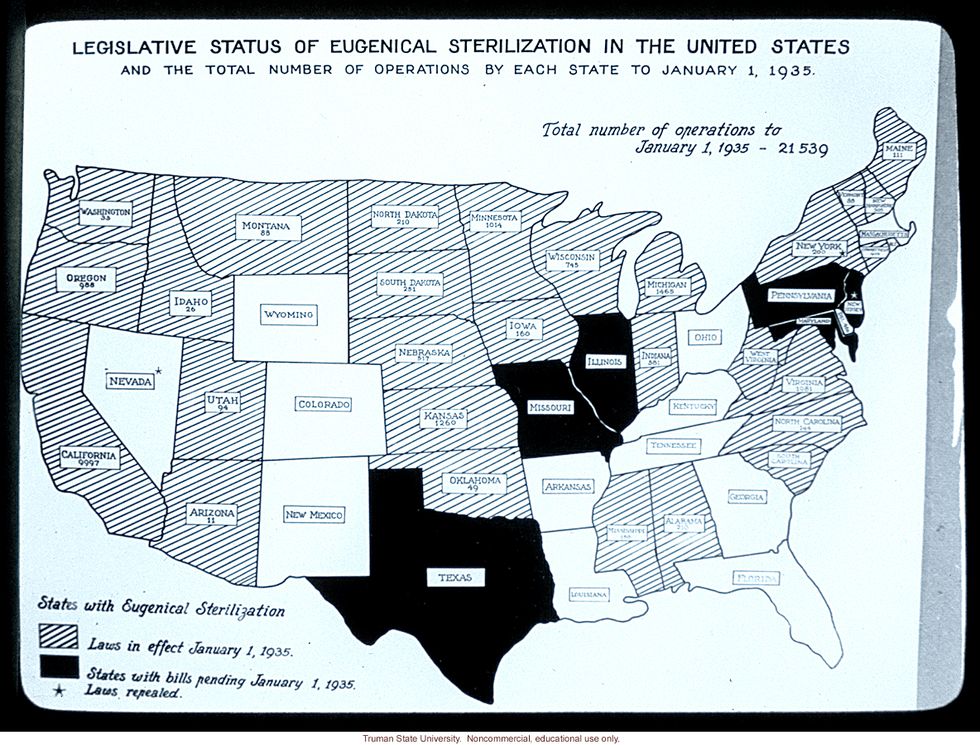I will never be able to cover the extensive history of Eugenics in the United States in this article alone. In order to do so, I would have to have an entire series of posts devoted to said topic. I will, however, try to give the best introduction to eugenics in the United States that I can, in the few words I have.
Many people have no idea what eugenics is, and for those who do, they rarely associate eugenics with the United States. Most people associate eugenics with Nazi Germany under Adolf Hitler and the building of the "Aryan" or ideal race. In actuality, this idea of a superior race originated in the United States decades before Hitler came to power in Germany, and the Germans adopted these ideas from the United States.
So much for "bring me your huddled masses." More like, bring me your blond hair blue eyed superior individuals so that we can play God.
Eugenics, by definition, is "the selection of desired heritable characteristics in order to improve future generations, specifically in reference to humans." The modern understanding of eugenics dates back to the late 19th century, when it was not uncommon to select mates and arrange marriages specifically to produce offspring with the most desirable traits. The term eugenicswas coined by Francis Galton, the cousin of Charles Darwin, who was greatly influenced by the theory of natural selection. The ideas of eugenics crossed the Atlantic and made their way to the United States when Gregor Mendel's principles of heredity were rediscovered.
During the early 1900s, eugenics became a legitimate scientific study, the biggest concern being predicting intelligence and deviant behaviors. These ideas were not just studied but put into practice, and the eugenics movement started in the United States during the progressive era (the 1890s to 1920s), continuing until 1940 and continuing in various forms until the 1980s.
Let's think about why this pseudo-science created such a following in the United States. During this time period, not only was there rampant and blatant racism against the newly freed Africans, but there was also an influx of immigrants who also faced racism and discrimination. In all of this chaos, the only saving grace the fragile white people had was the idea that through a repressive and racially revamped eugenic movement which would populate the world with more Nordic type white people and less or none of everyone else. Those who were deemed unfit were the freed Africans, Asian laborers, Native Americans, "Hispanics," East Europeans, Jews, "dark haired hill folk, the poor, the sick/disabled and everyone else who did not fit into the tall, strong, talented, blond, blue-eyed Nordic mold.
What did the eugenics movement entail in the United States?
FORCED STERILIZATION
We know of the mandated segregation of old, maintained by various segregation laws. What many do not know of are the forced sterilization and other eugenics-based laws which were adopted by twenty-seven states in the United States, most notably California, which is considered the "epicenter of the American eugenics movement." Not only was forced sterilization of certain individuals, such as criminals and the disabled, mandated, but so was the barring of marriages and the forcible segregation of others into colonies. The last legal forced sterilization in the United States was performed in Oregon in 1981.
The ideas of eugenics were so deeply ingrained in this country that these ideas were endorsed and upheld by the United States Supreme Court. In the infamous 1927 decision of the Buck v. Bell case, Supreme Court Justice Oliver Wendell Holmes wrote that "...Three generations of imbeciles are enough" when the Supreme Court ruled that compulsory sterilization of the "unfit" was not a violation of the Due Process clause of the 14th Amendment. The words of Supreme Court Justice Oliver Wendell Holmes were used several years later by the Nazis in their defense during the Nuremberg trials. Along with Brown v. The Board of Education, Roe v. Wade, Dred Scott v. Sandford and Griswold v. Connecticut, Buck v. Bell is one of those Supreme Court cases that are essential to our knowledge as citizens in this country and allow us to understand the way things were and the present state of the nation.
This piece by no means gives a comprehensive history of the eugenics movement in the United States, but instead should be used as a stepping stone from which to start further research on the topic. Things like this are the reason why the conscious people of this country shuddered at Trump's utterance of "Make America Great Again." With a better understanding of the legacy of this nation, I dare you to tell me – when was "America" ever great, and for who was it great?
Nothing is ahistorical.
We need to know the truths of our past in order to recognize their remnants in the present and move towards a truly better future for ALL.
Stay informed.

















